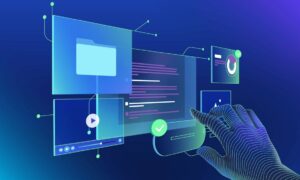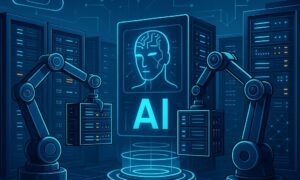Artificial Intelligence (AI) has transformed into one of the most powerful agents of change in healthcare over the past decade. The opportunities for healthcare organizations to start using AI and deliver more efficient, impactful, and precise interventions to patients are plenty from risk assessment and diagnosis to the choice of treatment procedures.
AI is expected to keep driving innovations and improvements across the care continuum as the volume of healthcare data keeps increasing. This is based on the ability of both AI tools and machine learning (ML) algorithms to deliver intelligent, proactive, and often hidden insights that guide the decision-making process in diagnosis and treatment.
AI can be highly beneficial to providers and patients alike when it is applied in the following areas: improvement of care, early risk identification, chronic disease management, workflow automation, and optimization. AI consulting services will help organizations make the most of AI in healthcare. To ensure that providers best understand how to make the most of AI within their ecosystem, it is important to look at the top 5 benefits of using AI in healthcare.
1) Population Health Management
AI can be used in healthcare organizations for aggregating and analyzing the health data of patients to proactively identify and prevent risk, seal off gaps in preventive care, and gain a better understanding of how the population is affected by clinical, genetic, environmental, and behavioral factors.
The combination of diagnostic data, unstructured narrative data, and exam findings provides a holistic view of the health of patients and reveals actionable insights that not only prevent disease but also promote wellness. AI-powered tools can be used for collating, analyzing, and comparing various such data points against population-level patterns to help identify early disease risks.
It is possible to glean predictive analytics since these data points are compiled to provide a view into the population. These insights can be subsequently used for risk stratification of populations on the basis of phenotypic and genetic factors as well as social determinants and behavioral drivers. Healthcare organizations can use these insights to provide more personalized, data-driven care while optimizing resource utilization and allocation and eventually leading to better outcomes for patients.
2) Clinical Decision Making
The use of AI in certain healthcare processes helps reduce the resources and time required to examine and diagnose patients. Armed with this, medical personnel are better able to save more lives by acting more quickly.
Machine learning (ML) algorithms are able to identify risk at a much faster rate and with far greater accuracy than traditional workflows. Done right, these algorithms can automate inefficient, manual processes thereby speeding up diagnosis while reducing diagnostic errors, which is still the single largest source of medical malpractice claims.
Furthermore, AI-enabled solutions can compile and comb through vast quantities of clinical data thus providing clinicians with a more holistic view of the health status of patient populations. Such solutions give the care team access to real-time or near-real-time actionable information at the right time and place thus driving significantly better outcomes.
Automating the aggregation and interpretation of the vast quantities of data flowing within the hospital walls allows the whole care team to worktop of license.
3) AI-Assisted Surgery
Surgical robotics applications are perhaps one of the most innovative uses of AI in healthcare. The maturity of AI robotics has led to the development of AI surgical systems capable of accurately executing even the tiniest of movements with perfect precision.
Such systems are capable of performing complex surgical operations, thereby reducing the average wait period for procedures along with the risk, loss of blood, complications, and possible side effects of the said procedures.
4) Improved Accessibility to Healthcare
Studies show significant gaps in the average life expectancy between the developed and underdeveloped countries due to limited or zero accessibility to healthcare. Developing countries are currently lagging behind their counterparts when it comes to deploying and leveraging innovative medical technologies capable of delivering appropriate care to the population.
Furthermore, a shortage of qualified healthcare professionals (including radiologists, surgeons, and ultrasound technicians), as well as properly equipped healthcare centers, impacts the delivery of care in such places. AI allows for the creation of digital infrastructure capable of facilitating quicker diagnosis of symptoms and triaging patients to the right modality and level of care to foster a more efficient healthcare ecosystem.
AI in healthcare can also help mitigate the shortage of professionals in remote areas that lack proper resources by taking over various diagnostic duties. For example, leveraging machine learning for imaging allows for the rapid interpretation of diagnostic studies such as MRIs, CT scans, and X-rays.
Teaching institutions are also increasingly leveraging these tools to ensure better training for residents, students, and fellows while reducing the risk to patients along with diagnostic errors.
5) Optimizing Performance and Operational Efficiency
Modern healthcare operations are a complex combination of systems and processes that are deeply interconnected. This can make it rather difficult to optimize cost while maximizing asset utilization and guaranteeing low wait times for patients.
Artificial intelligence is increasingly being used in health systems for the purpose of sifting through the large volumes of data in their digital ecosystem thus gaining insights that can help drive productivity, improve processes, and optimize performance.
For instance, artificial intelligence and machine learning can:
– Improve the throughput and ensure the effective and efficient use of facilities through the prioritization of services on the basis of patient acuity along with the availability of resources.
– Improve revenue cycle performance through the optimization of workflows, such as prior authorization claims and denials.
– Automating the routine, repeatable tasks to better deploy human resources when and where they are needed the most.
If used in a strategic way, both artificial intelligence and machine learning can provide clinical leaders and administrators with the necessary wisdom to improve the speed and quality of hundreds of decisions they need to make every day, thereby facilitating the smooth transition of patients through different clinical services.



































